51 dicas de especialistas sobre métodos de controle de estoque:escolha de um método de controle de estoque, dicas de coleta e análise de dados e implementação de políticas sólidas de controle de estoque
O controle de estoque é uma função crítica para empresas que abrangem todos os setores. Sem métodos eficazes de controle de estoque, a cadeia de suprimentos sofre, você não consegue atender adequadamente às necessidades do cliente e, em última análise, o resultado final de sua empresa refletirá essas inadequações.
Mas escolher o método certo para controle de estoque e desenvolver políticas eficazes garantir que os processos sejam seguidos, melhorar a precisão dos seus métodos de controle de inventário e coletar dados precisos para entender como usar esses dados para informar outras áreas da empresa são preocupações sem soluções simples e abrangentes.
É por isso que avaliar o cenário de negócios atual da sua empresa para identificar as principais necessidades e escolher sistemas e desenvolver processos que melhor atendam a essas necessidades exclusivas geralmente é um primeiro passo necessário para empresas que estão selecionando um sistema de controle de estoque pela primeira vez. Também é uma boa ideia que as empresas realizem essas auditorias periodicamente para garantir que os sistemas e processos atuais sejam adequados considerando crescimento ou mudança que ocorreu dentro da organização.
Para ajudar as empresas a escolher ou desenvolver metodologias adequadas aos negócios requisitos, compilamos uma lista de 51 dicas de especialistas sobre métodos de controle de estoque, que vão desde informações para ajudá-lo a escolher a estrutura ou metodologia de controle de estoque correta até entender as necessidades comerciais exclusivas de sua empresa e criar e aplicar políticas eficazes de controle de estoque. Para procurar dicas em uma seção específica, use os links abaixo para navegar para cada categoria.
Ir para:
- Escolhendo o método correto de controle de estoque
- Noções básicas de controle de estoque
- Dicas de coleta e análise de dados para um controle eficaz de inventário
- Conhecer seu inventário e as necessidades de sua empresa
- Criação de políticas eficazes de controle de estoque
Escolhendo o método de controle de inventário correto
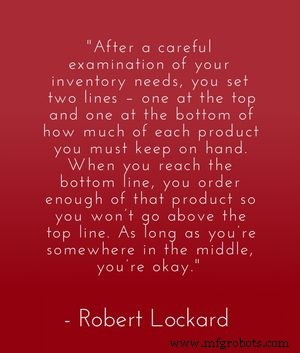
1. O método de controle de estoque Min-Max ajuda você a definir quanto estoque você deve manter para itens específicos. “Após um exame cuidadoso de suas necessidades de estoque, você define duas linhas – uma na parte superior e outra na parte inferior de quanto de cada produto você deve manter à mão. Quando você alcança o resultado final, você pede o suficiente desse produto para não ultrapassar o resultado final. Contanto que você esteja em algum lugar no meio, tudo bem.
“Prós:Este método é simples e torna a tarefa de balanceamento de estoque bastante simples.
“Contras:Sua simplicidade pode levar a problemas porque você pode encomendar muitos produtos ou acabar antes que eles cheguem.” – Robert Lockard, 4 métodos de controle de estoque que você precisa conhecer , Software do Sistema de Inventário; Twitter:@Fishbowl
2. O método ABC é um dos métodos de controle de estoque mais usados em alguns setores. “Este é um dos métodos comuns usados no setor de varejo e, às vezes, é acoplado a outros métodos para melhor controle do estoque. Esta é mais uma técnica de classificação de estoque onde os produtos são classificados com base na contribuição de vendas e importância dos mesmos em seu plano de sortimento.
“Os produtos da categoria A serão os mercearias máximos em vendas e produtos emblemáticos com maior margem . Normalmente, os 20% dos produtos do sortimento que contribuem para 80% do total de vendas são classificados na categoria A, onde é necessário um controle rígido do estoque para garantir que não haja perda nas vendas. 20% dos produtos que contribuem para 80% das vendas é conhecido como Regra 80-20 ou Princípio de Pareto
“Os produtos da categoria C são os últimos que contribuem menos para as vendas. Esses itens são marginalmente importantes para o negócio e são mantidos apenas para o único propósito de exigência do cliente.
“Os produtos da categoria B são importantes para o varejista, mas são menos importantes em comparação com os produtos da categoria A.” – Suresh Ram, Tipos de sistemas de controle de estoque , Discutir o varejo em detalhes
3. O inventário gerenciado pelo fornecedor é uma opção para alguns setores. “Como o nome indica, o inventário gerenciado pelo fornecedor (VMI) é o inventário gerenciado pelo fornecedor (fornecedor). E embora possa haver mais do que isso, no mínimo isso significa que o fornecedor determina quando reabastecer e quanto reabastecer.
“O estoque gerenciado pelo fornecedor não é novidade; na verdade, já existe há muito tempo e é muito mais comum do que você imagina. Se você já trabalhou em um restaurante, você teria visto o “cara do pão” aparecer todos os dias, verificar seu inventário (olhar fisicamente para seus pães, pães, etc.), depois ir até o caminhão dele e estocar você. . Em uma barbearia, muitos dos produtos de cabelo que seu barbeiro (sim, sou da velha guarda, vou a um barbeiro) vende ou usa também são gerenciados pelo fornecedor. Nesse caso, provavelmente é o representante de vendas desse produto que realmente “gerencia” o estoque, e ele pode reabastecer a barbearia do porta-malas do carro. Na antiga loja de ferragens independente, itens como porcas, parafusos, arruelas, anéis de vedação, etc. eram frequentemente gerenciados pelo fornecedor. Em empresas maiores, você pode ter suas caixas de remessa, materiais de escritório ou suprimentos de limpeza/manutenção gerenciados pelo fornecedor.” – Dave Piasecki, Vendor-Managed Inventory (VMI):o que é e quando faz sentido usá-lo , InventoryOps.com
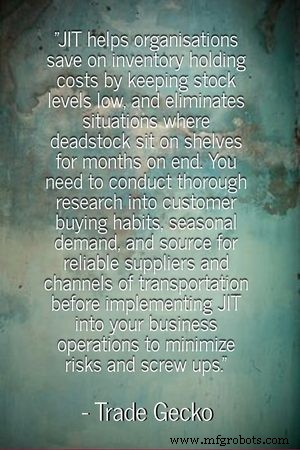
4. O método de controle de estoque Just In Time é considerado uma prática arriscada, mas reduz o volume de estoque que uma empresa mantém disponível, o que pode reduzir os custos indiretos. “O método Just In Time (JIT) funciona para diminuir o volume de estoque que uma empresa tem em mãos. É considerada uma técnica arriscada porque você só compra estoque alguns dias antes de ser necessário para distribuição ou venda, para que os itens cheguem a tempo de uso.
“O JIT ajuda as organizações a economizar nos custos de manutenção de estoque, mantendo os níveis de estoque baixo e elimina situações em que o estoque morto fica nas prateleiras por meses a fio. Você precisa realizar uma pesquisa completa sobre os hábitos de compra dos clientes, a demanda sazonal e a fonte de fornecedores e canais de transporte confiáveis antes de implementar o JIT em suas operações comerciais para minimizar riscos e estragar tudo.” – Técnicas de gerenciamento de estoque em> , Gecko Comercial; Twitter:@tradegecko
5. Os métodos de inventário de vários períodos têm duas variações principais:quantidade de pedido fixo e pedido de período fixo. “Um modelo de inventário de vários períodos pode ter duas variações. Os sistemas de quantidade fixa de pedidos são onde os pedidos são feitos por um valor fixo cada vez que são feitos. A colocação de um pedido é feita quando ocorre um evento – como atingir um nível mínimo de estoque. A segunda variação são os modelos de período de tempo fixo onde os pedidos são feitos em horários específicos, por exemplo, quando há uma revisão mensal dos níveis de estoque. O valor do pedido dependerá da quantidade de estoque necessária.
“As principais diferenças entre esses modelos são que, em um modelo de quantidade de pedido fixo, deve haver monitoramento contínuo para garantir que os pedidos sejam feitos quando os níveis de estoque forem atingidos. reduzido ao nível adequado. Os níveis de estoque em um modelo de período de tempo fixo são verificados apenas no momento em que um pedido deve ser feito. No modelo de quantidade de pedido fixo, os níveis de estoque geralmente são mais altos e esse sistema tende a ser usado para itens mais caros e importantes. Também requer mais tempo para manutenção porque os modelos de estoque precisam ser constantemente medidos.
“Os modelos de quantidade de pedido fixos são usados em situações muito estáveis onde a demanda do produto é constante, o lead time do produto é conhecido e confiável, o preço não varia, os custos de pedido são constantes e todos os pedidos do produto serão atendidos.” – Peter Carr, Semana 7:Gerenciamento de estoque , BE 603 Operations and Supply Chain Management (oferecido pelo Conrad Center for Business Entrepreneurship and Technology da University of Waterloo); Twitter:@UWaterloo
6. Os métodos de controle de estoque mais eficazes podem variar de empresa para empresa e até mesmo para categorias de itens individuais. “Os métodos de controle de estoque variam de empresa para empresa, mercadoria para mercadoria e SKU para SKU. O método de controle de estoque que funciona melhor para itens de movimentação lenta pode não funcionar tão bem para itens de movimentação rápida. Uma empresa pode ter 1 milhão de SKUs diferentes e usar apenas cinco métodos diferentes de controle de estoque. Uma coisa a ser lembrada – não existe um método perfeito para gerenciar o estoque. Um santo graal ou fórmula mágica que resulta em níveis de estoque perfeitos não existe. Uma empresa só pode procurar encontrar o melhor método que resulte em redução de custo e aumento dos níveis de serviço.” – Kenneth Hamlett, Métodos para controle de inventário , Chron.com; Twitter:@HoustonChron
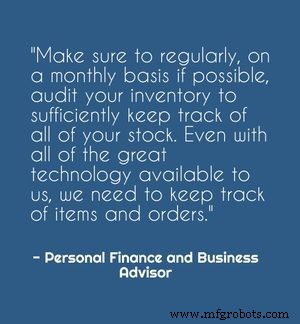
7. Embora não haja necessariamente uma metodologia de controle de estoque de tamanho único, desenvolver um sistema de controle de estoque claro e políticas associadas é essencial para o sucesso de qualquer empresa. “Para entender as diversas técnicas de gestão de estoque é fundamental saber por que ela é importante.
- Primeiro, um estoque mal administrado pode levar a um aumento desnecessário do capital de giro. Os fundos excedentes poderiam ter sido direcionados de forma proveitosa para alimentar as iniciativas de crescimento da empresa ou os esforços de pesquisa e desenvolvimento.
- Segundo, o gerenciamento de estoque eficaz levaria a baixos custos de armazenamento, o que, por sua vez, levaria a um aumento nos lucros da empresa. O espaço de armazenamento é caro; se você conseguir gerenciar bem seu estoque e reduzir a quantidade de mercadorias que precisa armazenar, precisará de menos espaço, o que, por sua vez, levará a baixos custos de aluguel de armazém.
- Terceiro, pode ajudá-lo a satisfazer seus clientes fornecendo-lhes os produtos de que precisam da maneira mais rápida. A má gestão de estoque leva a uma menor disponibilidade de mercadorias e maior tempo de entrega. Portanto, se você deseja obter essas estrelas de satisfação do serviço, precisa gerenciar bem seu inventário.
- Quarto, mercadorias armazenadas no estoque por um longo período podem estragar. Isso leva a despesas desnecessárias na operação de um negócio. Portanto, o gerenciamento de estoque adequado pode ajudar a reduzir muito esses custos.
- Quinto, se você tiver estoques espalhados em vários locais, precisará de um sistema adequado para gerenciar esses estoques com base na demanda e na oferta. As técnicas de gerenciamento de inventário podem ajudá-lo a percorrer um longo caminho no gerenciamento de vários inventários.” – Laran Joseph, Técnicas de gerenciamento de inventário e sua importância , Blog da Udemy; Twitter:@Udemy_Blog
8. Procure os principais recursos para avaliar sistemas que permitem gerenciar o estoque da sua empresa digitalmente. “Não, não queremos dizer usar o Excel para rastrear seu inventário. Estamos nos referindo a uma solução de Gerenciamento de Estoque que funciona para o seu negócio. Nem todos os programas funcionarão para todos, portanto, dedique algum tempo avaliando os recursos e funções para garantir que ele atenda às suas necessidades e às necessidades do seu negócio. Aqui estão algumas ótimas dicas sobre como avaliar um sistema de gerenciamento de estoque.
- Baseado na Web: Ter uma solução baseada na web será inestimável. Esse tipo de sistema de controle de estoque geralmente é mais econômico, oferece mais recursos e geralmente é mais fácil de implementar.
- Inventário para celular: Você pode levar seu sistema de gerenciamento de estoque para qualquer lugar? Ser baseado na web não é suficiente, portanto, certifique-se de que seu sistema seja compatível com iPad, iPhone, Android ou Windows Mobile.
- Integração de código de barras: O código de barras permite reduzir os erros de entrada de dados, acelerar os processos de controle de estoque e facilitar as operações do dia-a-dia.
- Conversão de unidade de medida: Usar um sistema que entenda sua unidade de medida de compra é muitas vezes diferente de sua unidade de medida de estoque é vital. Você pode comprar seu “widget” pelo “case” da Acme Supply, mas você pode emitir esse mesmo “widget” para sua equipe pela “cada” unidade de medida. Muitas vezes você pode ver um cenário em que pode haver 50 “cada” em um “caso” que foi encomendado. É vital que seu sistema de gerenciamento de inventário conheça e entenda esse processo.
- Importação de dados: Importar seus dados inicialmente economizará horas, se não dias, de digitação manual de todos os seus suprimentos. Certifique-se de verificar esta funcionalidade.
- Processos em lote: Ninguém gosta de ter que realizar a mesma tarefa repetidamente; certifique-se de que o sistema escolhido oferece transações em massa ou processos em massa para transformar grandes trabalhos em tarefas de fácil execução.
- Ciclo/contagens físicas: Eventualmente, a quantidade de suprimentos em suas prateleiras não será igual à quantidade desse item em seu software de gerenciamento de estoque, portanto, a contagem cíclica ou física de seus suprimentos precisa ser rápida e fácil. Verifique se o sistema selecionado oferece uma maneira rápida e fácil de executar essas funções.
- Alertas e notificações: Mantenha-se informado com Alertas de Par Baixo e outras várias notificações do sistema automaticamente. Ninguém gosta de surpresas e com alertas automatizados você nunca mais será surpreendido.” – 5 práticas recomendadas simples para um ótimo gerenciamento de inventário , O Grupo de Ferramentas; Twitter:@TheToolkitGroup
Noções básicas de controle de estoque
9. Seu sistema de controle de inventário deve conter vários elementos-chave. “Toda operação de peças precisa de algum tipo de sistema de controle de estoque, que deve incorporar os seguintes elementos-chave:
- Deve avisar o pessoal de peças com bastante antecedência que uma peça está se esgotando no estoque.
- Ele deve listar o preço de compra histórico de uma peça para que, se o preço mudar, o gerente possa analisar o problema e verificar se essa alteração é um aumento de preço ou devido a um faturamento incorreto.
- Deve listar os fornecedores que oferecem os melhores preços.
- Ele deve fornecer as taxas de uso anteriores para que o gerente possa determinar os níveis de inventário adequados.
- Deve exigir o mínimo de redação possível, principalmente por parte da mecânica.” – John Dolce, 15 dicas para melhorar seu controle de estoque , Profissional de Frota Utilitária; Twitter:@UtilityFleetPro
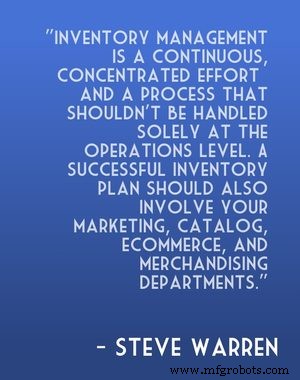
10. Faça um plano primeiro e depois execute. “O gerenciamento de estoque é um esforço contínuo e concentrado – e um processo que não deve ser tratado apenas no nível operacional. Um plano de estoque bem-sucedido também deve envolver seus departamentos de marketing, catálogo, comércio eletrônico e merchandising.
“Ao gerenciar seu estoque de acordo com um calendário promocional mestre, todos ganham:sua equipe de compras entende quando e quanto produto comprar, seu atendimento O provedor sabe quando preparar espaço adicional no depósito, e sua equipe de contact center pode antecipar o aumento do volume de chamadas.
“Adicione previsões de vendas de anos anteriores ao seu calendário de estoque para estar ainda mais preparado para picos sazonais de demanda.” – Steve Warren, 4 dicas para um gerenciamento de estoque eficaz , Comerciante Multicanal; Twitter:@mcmerchant
11. Identifique peças de reposição essenciais para o inventário de manutenção e garanta que elas estejam sempre em estoque. “Você identificou suas peças críticas? Sobressalentes críticos =Longo prazo de entrega (4-6 semanas) X Crítico para o equipamento de produção X Alto custo da peça. Essas peças são como um seguro de vida. Você espera nunca precisar deles, mas é melhor que eles estejam na prateleira se precisar.” – Melhorar o controle de estoque de manutenção , Instituto Marshall; Twitter:@Marshall_Inst
12. As remessas devem ser analisadas de perto, pois o recebimento de estoque é um ponto-chave de perda. “Um ponto chave de perda é na hora de receber o estoque. Revisar de perto as guias de remessa para catalogar remessas é necessário para o gerenciamento de estoque. Você também deve inspecionar cuidadosamente os itens antes que a empresa de transporte parta, caso precise registrar uma reclamação por danos. Cada remessa deve ser verificada de perto, e isso deve incluir a contagem de produtos e a comparação com a guia de remessa. As variações precisam ser observadas e, se necessário, uma reclamação deverá ser apresentada ao fornecedor responsável pela remessa.” – Gerencie seu inventário , Couve; Twitter:@KabbageInc
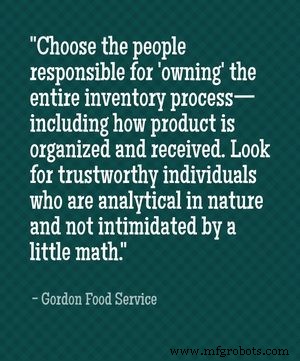
13. Atribua à equipe de gerenciamento de inventário certa a tarefa de controlar os processos de controle de inventário da sua organização. “Escolha as pessoas responsáveis por ‘possuir’ todo o processo de inventário – incluindo como o produto é organizado e recebido. Procure indivíduos confiáveis que sejam analíticos por natureza e não se intimidem com um pouco de matemática.” – 7 dicas para melhorar o estoque da sua operação e reduzir o desperdício de alimentos , Serviço de Alimentação Gordon; Twitter:@GFSDelivers
14. Como o estoque deve ter um único local de armazenamento, com exceção de um local de excesso de estoque, se necessário. “Reúna estoques semelhantes em um único local de armazenamento. A mesma peça não deve estar em várias áreas de armazenamento, a menos que o tamanho físico determine uma limitação. Nesse caso, mantenha as quantidades disponíveis no mínimo e mova o restante para um local que não faça parte do armazenamento de fácil acesso (local de excesso de estoque).” – Dicas de gerenciamento de armazém para estoque de contagem física , riteSoft
15. O controle de estoque bem-sucedido é encontrar o equilíbrio certo entre os custos do estoque e os benefícios do estoque. “O gerenciamento de estoque bem-sucedido envolve equilibrar os custos do estoque com os benefícios do estoque. Muitos proprietários de pequenas empresas não conseguem avaliar totalmente os verdadeiros custos de manutenção de estoque, que incluem não apenas os custos diretos de armazenamento, seguro e impostos, mas também o custo do dinheiro atrelado ao estoque. Essa linha tênue entre manter muito estoque e não o suficiente não é a única preocupação do gerente. Outros incluem:
- Manter uma grande variedade de estoque, mas não espalhar muito os que se movem rapidamente;
- Aumentar a rotatividade do estoque, mas sem sacrificar o nível de serviço;
- Mantendo o estoque baixo, mas sem sacrificar o serviço ou o desempenho.
- Obter preços mais baixos ao fazer compras em volume, mas não acabar com estoques de baixa movimentação; e
- Ter um inventário adequado à mão, mas não ser pego com itens obsoletos.
“O grau de sucesso em abordar essas preocupações é mais fácil de avaliar para alguns do que para outros. Por exemplo, calcular o índice de rotatividade de estoque é uma medida simples de desempenho gerencial. Esse valor fornece uma diretriz aproximada pela qual os gerentes podem definir metas e avaliar o desempenho, mas deve-se perceber que a taxa de rotatividade varia com a função do estoque, o tipo de negócio e como o índice é calculado (seja sobre vendas ou custo de mercadorias vendido). Os índices médios de giro de estoque para indústrias individuais podem ser obtidos de associações comerciais.” – Gerenciamento de Estoque – Gerenciamento de Estoque bem-sucedido , IPSCMI
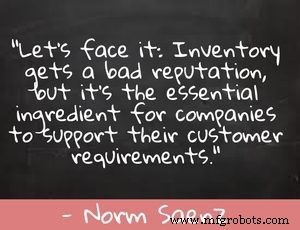
16. O inventário tem uma má reputação, mas é uma função crítica para negócios que abrangem quase todos os setores. “Vamos ser sinceros:o estoque tem uma má reputação, mas é o ingrediente essencial para as empresas atenderem às necessidades de seus clientes. Eles devem ter o que seus clientes-alvo precisam para manter seus negócios e vencer a concorrência ao máximo. Este último fato é o motivo pelo qual tantas empresas mantêm estoques muito lentos ou “mortos” nas prateleiras.
“Os requisitos de estoque em uma determinada empresa variam de acordo com os requisitos de suporte ao cliente e o tipo de negócio sendo um fabricante, varejista , distribuidor atacadista ou empresa de comércio eletrônico. Mesmo dentro dessas categorias gerais de canais, haverá diferenças significativas no gerenciamento de estoque em produtos farmacêuticos/medicamentos, alimentos, vestuário, mercadorias em geral, automotivo, eletrônicos, materiais de construção e outros tipos de negócios.
“Enquanto a indústria e serviços os níveis influenciam as práticas de estoque, existem razões comerciais gerais pelas quais algumas empresas têm estoque em excesso, como risco e incerteza da cadeia de suprimentos e do fornecedor; demanda variável do cliente e precisão da previsão; nivelamento de sazonalidade; questões de prazo de entrega; cobertura de preços; risco de perder clientes fiéis; e marketing impulsionando as vendas com novas mercadorias.” – Norm Saenz, diretor administrativo da St. Onge; Don Derewecki, consultor sênior da St. Onge, Gerenciamento de estoque 101:hora de revisitar os princípios , Gestao de logistica; Twitter:@LogisticsMgmt
17. O controle de estoque ruim é, na verdade, um sintoma de um problema muito mais profundo, como uma manutenção ruim ou um plano de gerenciamento de instalações ruim. “Tempo de inatividade:é uma palavra que todo gerente do setor de manutenção e confiabilidade teme. Nas melhores situações, isso significa uma perda de lucro. Na pior das hipóteses, isso significa uma perda de seu emprego. Embora nem todos os problemas que causam tempo de inatividade sejam completamente evitáveis, ajuda saber quais são. Nesta postagem do blog, examinaremos algumas maneiras infalíveis de eliminar o tempo de inatividade com algumas dicas de controle de estoque.
“Você pode estar se perguntando o que o controle de estoque tem a ver com o fato de uma loja sofrer ou não com o tempo de inatividade , ao qual eu responderia, 'muito.' O controle de estoque ruim é um sintoma de um problema muito mais profundo, ou seja, um mau plano de manutenção e/ou gerenciamento de instalações.
“Um dos principais passos para qualquer sistema de gerenciamento de manutenção é conhecer cada equipamento sob sua responsabilidade. Isso inclui informações sobre o maquinário também, incluindo a idade de cada unidade, quem é o fornecedor, as informações de contato do fornecedor, expectativa de vida do produto, procedimentos de manutenção sugeridos… a lista continua.
“Sabendo essas informações vitais, você pode desenvolver um plano de manutenção sólido para garantir que seu equipamento continue funcionando corretamente, ajudando assim a evitar um possível cenário de tempo de inatividade futuro.” – Lisa Richards, Banir o tempo de inatividade com essas dicas de controle de estoque em> , MapCon; Twitter:@MAPCONtech
18. O controle de estoque, apesar de sua importância, ainda é uma função que permanece desatualizada em alguns ambientes, como consultórios de prestadores de serviços de saúde. “Muitos escritórios não têm sistema de controle de estoque e, portanto, enfrentam escassez de suprimentos que exigem pedidos de última hora a preços premium. A maioria das práticas não pode pagar ou não tem volume para suportar sistemas de controle de scanner digital. O custo da ineficiência do médico devido à falta de itens muitas vezes é maior do que o custo dos suprimentos.
“O sistema manual a seguir é simples e fácil de usar, que coloca o controle do estoque nas mãos de uma pessoa enquanto ainda permitindo que qualquer pessoa no escritório use suprimentos quando necessário sem primeiro ter que verificar com outra pessoa. Subsistemas para abastecer cada sala de exame ou estação de trabalho também podem ser criados, se desejado.
“O sistema:
- Determine o ciclo de compra de cada item (com que frequência você comprará:semanal, mensal, trimestral etc.), dependendo da utilização e do espaço de armazenamento. A maioria dos escritórios deve solicitar suprimentos semanalmente ou mensalmente. Se você tiver um subsistema para salas de exame ou estações de trabalho, seu ciclo se aplicará ao reabastecimento dessas áreas da sala de suprimentos.
- Determine a quantidade de cada item normalmente usado durante cada ciclo de compra.
- Inicialmente, compre o suficiente de cada item para durar dois ciclos de compra e crie dois pacotes de cada item. Cada pacote deve conter o suficiente de cada item para durar um ciclo de compra (exceto itens com data de validade ou itens sazonais, como vacina contra gripe). Enrole cada pacote com um pedaço de barbante ou elástico, ou coloque cada pacote em uma caixa, saco ou outro recipiente separado. Em cada pacote, anexe uma etiqueta reutilizável com o nome do item, fornecedor, último preço pago por unidade, ciclo de compra, valor do pedido e contagem de itens do pacote.
- Prenda com destaque um envelope com a inscrição “Reordenar envelope. Coloque as etiquetas aqui” no almoxarifado.
- Quando os suprimentos são necessários, qualquer funcionário pode acessar um pacote, remover a etiqueta e colocá-la no envelope de novo pedido. Um pacote completo e um parcial devem permanecer para o item acessado.
- Atribua um funcionário de controle de estoque para processar etiquetas e rótulos de controle de estoque e solicitar novos suprimentos de acordo com o ciclo de compra. Se o seu funcionário encomendar suprimentos on-line, peça-lhe que verifique se o fornecedor on-line tem uma função em que pedidos novos iguais a um de seus pacotes podem ser feitos de maneira rápida e fácil.
- Quando os suprimentos chegam, o funcionário de controle de estoque deve ser o único a abrir a entrega, comparar a fatura de entrega com o pedido original para confirmar a precisão e guardar os itens.
- Reagrupe os itens e reconecte a tag usada ao novo pacote para concluir o ciclo de pedidos.
- Coloque o novo pacote de itens atrás do pacote restante, que já pode ter sido aberto se a demanda por um item aumentou inesperadamente (por exemplo, para alternar o estoque).
“Você pode alterar fornecedores, ciclos de compra, valores de pedidos e tamanho do pacote a qualquer momento, conforme necessário. Basta alterar as tags para refletir as alterações.” – Keith Borglum, Perguntas e respostas:dicas para economizar dinheiro em suprimentos e controlar o estoque , Rede de Medicina Moderna; Twitter:@MedEconomics
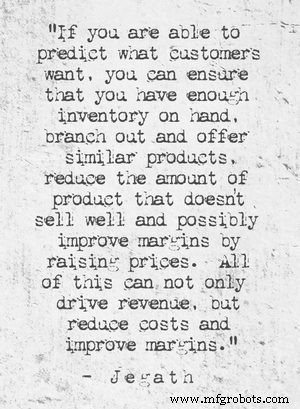
19. As pequenas empresas não devem ignorar a necessidade de um sólido sistema de controle de estoque. Ao considerar métodos e aplicativos de software, em vez de optar pelo aplicativo mais barato ou gratuito, escolha um sistema que possa crescer com seus negócios. “Você pode estar pensando que, como sua empresa é pequena, não precisa gastar muito tempo e dinheiro acompanhando meu estoque. Com o tamanho do seu negócio, você pode ficar de olho nele mesmo sem precisar configurar um sistema especial.
“Essa linha de pensamento pode causar problemas. O gerenciamento de estoque envolve mais do que apenas contar seu estoque. Um bom sistema de gerenciamento de estoque também abrange o rastreamento do estoque à medida que ele é enviado aos clientes. A partir do gerenciamento de estoque adequado, você pode aprender quais produtos estão vendendo bem e quais não estão, para saber o que estocar mais e quais itens considerar colocar à venda para movê-los. Se você conseguir prever o que os clientes desejam, pode garantir que tenha estoque suficiente disponível, ramifique e ofereça produtos semelhantes, reduza a quantidade de produtos que não vendem bem e possivelmente melhore as margens aumentando os preços. Tudo isso pode não apenas aumentar a receita, mas também reduzir custos e melhorar as margens.
“O software de gerenciamento de estoque para pequenas empresas também pode ajudar no gerenciamento de caixa. Ao entender quais produtos vendem e usar isso para controlar seu comportamento de compra just-in-time, você pode reduzir o ciclo de conversão de caixa para o seu negócio. Da mesma forma, ao eliminar produtos e skus que não vendem, você pode reduzir a quantidade de dinheiro vinculada a produtos de conversão de dinheiro longos. Tudo isso é fundamental para as pequenas empresas. A questão não é 'preciso de um sistema de gestão de estoque', mas 'quanto dinheiro e tempo devo investir'. Então você também precisa considerar o crescimento. A troca de sistemas mais tarde pode ser muito perturbadora e dolorosa. Embora o software gratuito de gerenciamento de estoque esteja disponível para sua pequena empresa, essa pode não ser a melhor estratégia de longo prazo. É melhor comprar um serviço ou produto que possa crescer com você.” – Jegath, Dicas para proprietários de pequenas empresas:como gerar receita por meio do software de gerenciamento de inventário para pequenas empresas , Blog Ordoro; Twitter:@ordoro
20. Para as organizações de manutenção, é fácil cair na armadilha de pensar que o CMMS certo também resolverá os desafios de controle de estoque da empresa. No entanto, o software de manutenção apenas automatiza e simplifica os processos que já são eficazes. “O gerenciamento eficaz de estoque é uma das melhores maneiras de acelerar o ROI de sua implementação de CMMS. O rastreamento de estoque, no entanto, pode ser uma tarefa complexa e assustadora. As organizações precisam rastrear uma variedade de equipamentos, bem como as peças de reposição e ferramentas usadas para manter adequadamente esses equipamentos.
“Durante muito tempo, as organizações tiveram que fazer o gerenciamento de estoque manualmente. A dificuldade de rastrear estoques em diferentes quantidades e com características variadas aumenta quando são utilizados procedimentos manuais. Um módulo de controle de estoque pode simplificar o gerenciamento de estoque por meio de uma melhor manutenção de registros e relatórios automatizados. Infelizmente, os módulos de gerenciamento de estoque são frequentemente subutilizados.
“Muitos gerentes de manutenção supõem erroneamente que o gerenciamento de estoque é uma função automática dos sistemas de gerenciamento de manutenção, mas o software de manutenção só pode simplificar e automatizar um processo que já é eficaz.” – Carol Owens, Dicas para simplificar o gerenciamento de estoque com o software de controle de manutenção , Business-Software.com; Twitter:@BiznessSoftware
21. Não importa quais sistemas de inventário, métodos e políticas você empregue, sempre tenha um plano de backup para proteger os dados valiosos da sua empresa. “Proteja todo o seu trabalho duro. Mesmo o sistema de inventário organizado e de alta tecnologia pode ser catastroficamente descarrilado, a menos que você tenha um plano de backup em vigor. E se, por exemplo, seu computador de última geração for roubado ou um incêndio danificar suas instalações, relegando seus registros escritos a uma pilha de cinzas? Evite esse cenário desastroso também fazendo backup de seu sistema em outro lugar, talvez até em um pen drive removível.” – Stephanie Howard, Dicas para assumir o controle de seus gerentes, fornecedores e estoque , Groov; Twitter:@GroovvSolutions
Data Collection and Analysis Tips for Effective Inventory Control
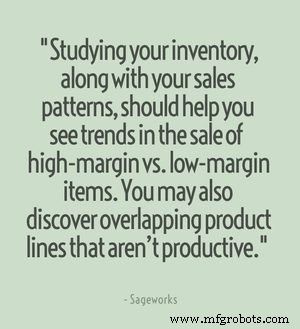
22. Find a way to evaluate what products are moving and what products are not. “One of the first ways to use your inventory information is to examine by product what is moving and what isn’t. Doing this on an ongoing basis will help identify products that may need to be discounted in order to replace them with faster selling items or in order to generate some cash. Studying your inventory, along with your sales patterns, should help you see trends in the sale of high-margin vs. low-margin items. You may also discover overlapping product lines that aren’t productive.” – Sageworks, 6 Tips to Improve Inventory Management , Funding Gates; Twitter:@FundingGates
23. Measurement is essential. You cannot control what you don’t measure. “Metrics are essential to a well-run supply chain. Metrics for their own sake, however, are worthless. The purpose of a metric is to drive change when the variable you are measuring trends in the wrong direction.
“A number of different metrics are useful for inventory management. Days supply by product and location based upon forecast is an excellent metric at the SKU level.
“When analyzing roll-up numbers for a product line, warehouse, or any other higher level, however, days supply is misleading because the lows cancel the highs and hide imbalances. At the higher level, inventory velocity is a much better measure of inventory health.
“No metric is useful, however, unless it is acted upon. Constant vigilance and early response to imbalances are the keys to ensuring best-practice inventory management.” – Jane B. Lee, 8 Common-Sense Rules for Inventory Management , Inbound Logistics; Twitter:@ILMagazine
24. Calculate your total costs. “It goes without saying that getting your inventory levels right is imperative, but what about the right quantities of your highest-performing brands and products? Maximizing sales of the goods with the most attractive margins can sometimes be tricky because of quantity discounts, special orders, and changes in wholesale prices (that you might not be aware of).
“It’s why looking carefully at total costs lets you know which products have the best margin, rather than just sell the fastest.
“Why calculate total costs?
- Focus on brands and vendors that yield the highest profits
- Find out which products perform the best by quantity margin
- Better manage discounts with a precise account of item cost” – Stephanie Braun, Fun Tips! 5 Ways To Improve Inventory Control Today , Lightspeed POS; Twitter:@LightspeedHQ
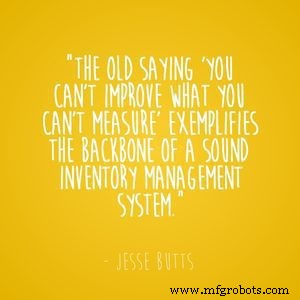
25. Track both inventory and sales data. “The old saying ‘you can’t improve what you can’t measure’ exemplifies the backbone of a sound inventory management system. If you haven’t yet started keeping thorough records, there’s no time like the present. As you create this records system, consider how it will accommodate the most vital inventory components:
- sales orders — documents comprising your customers’ purchase orders (requests for your product or service) in a format tailored for your business
- bills of materials — documents stating the inventory components (and hopefully labor) required to complete products or services
- work orders — if you’re involved in manufacturing, you’re probably familiar with these documents that include products’ details and their respective bills of materials
“You likely already have a system for recording transactions that includes sales orders (we hope). But most entrepreneurs haven’t taken the time to complete bills of materials, and for good reason:They are time-consuming. But, in the end, the benefits far outweigh the costs.
“Bills of materials are considerably easier to create for a retail storefront than for, say, a restaurant. In the food service industry, one sales order can relate to multiple bills of materials which, in turn, can require a few primary components and many others in small amounts. If you fall into the latter camp, determine the quantities of various invoice items needed for the appropriate bills of materials.” – Jesse Butts, How to Establish a Practical Inventory Management System , BizFilings; Twitter: @Toolkit
26. Check all stock inwards to account for errors in packing and other issues that may be missed if you simply assume the numbers match up. “The first focus should always be to check what actually gets delivered against what you have ordered from your supplier. It is so easy to assume that the numbers match up, but from talking to our customers we note that a good 1% to 2% of stock orders are incorrectly packed. If you just assume that you have the correct numbers of products when you add the inventory to your shelves you are liable to be short stocked when you receive a customer order. Another issue is that you might actually have more stock than you need and you won’t know when to reduce prices to move it or order more when you don’t need to.” – Stock Control and Inventory Management Tips , Cloud Fulfillment; Twitter:@CloudFulfillment
27. Centralize your data. “Regardless of how your inventory is set up physically, from a tracking perspective it should all be consolidated. This is especially the case if you have a web store and a physical one. Otherwise, you’ll appear disorganized and the process of buying could be confusing. As a bonus, being able to order online and either pick up or return in-store can seriously boost sales.” – 5 Tips for Streamlining Your Inventory Control Process , Blue Chip Inventory Service Int’l.; Twitter:@rodwalsh98
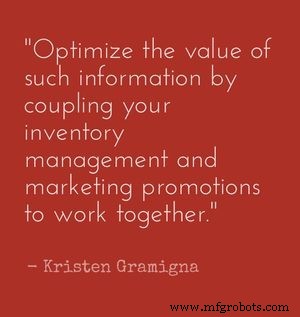
28. Inventory trends inform marketing plans. “Accurate inventory management incorporates what you know about customer and product demand from the past and present to (ideally) predict your best course of action in the future. A point of sale system can help quantify product level demand in tandem with recurring sales patterns, including those that fluctuate with some predictability (like seasonality, lifestyle occasions that impact your target audience and perhaps, local events).
“Optimize the value of such information by coupling your inventory management and marketing promotions to work together. For example, such insights can reveal potential opportunities to leverage quantity-based pricing vendors may offer, while at the same time empowering you to offset times of lower demand with promotions or ‘packaged’ deals that strategically drive sales, while moving the inventory that you acquired at a low cost.” – Kristen Gramigna, Keep Track of Your Precious Cargo:Tips for Inventory Management , Business.com; Twitter:@businessdotcom
29. Automate tracking with barcode labels and/or inventory management applications. “Another possible inventory management error is failure to track what you receive and what you sell. This can lead to losses, especially if you’re paying for products that are never showing up at your business, so some sort of tracking system is imperative. Automating the process with a barcode system and/or inventory management application is the smoothest way to handle this; note that the BizXpert app offers some useful inventory management features.
“Cycle counts are also recommended. Every day, pick a handful of items and count how many you have, comparing the number against what you have in your records. Pay special attention to big-selling and hot ticket items.” – Three Inventory Management Errors (And How to Avoid Them) , BizXpert; Twitter:@BizxpertApp
30. For many industries, including healthcare, inventory tends to follow the 80/20 rule. “Hospital inventory, like many things in life, often follows an 80/20 rule. 80% of the value of your inventory will be composed of just 20% of your actual product and most of those valuable items – whether they be assets, med-surg supplies, consignments or medication – fall into the departments of OR or Pharmacy. Plan your inventory efforts accordingly. Spend 80% of your time and energy optimizing the ordering and organization of the equipment, supplies and pharmaceutical products in these categories.” – Top 10 Tips for Hospital Inventory Management , Reliant Inventory Services
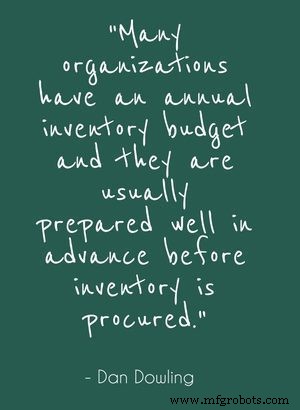
31. Inventory budgeting is a critical component of effective inventory control. “Many organizations have an annual inventory budget and they are usually prepared well in advance before inventory is procured. Budgets should include the total cost of ownership to keep inventory on hand during that year’s account period. This includes materials cost, fixed operational costs, carrying costs, logistics costs, redistribution costs and additional miscellaneous costs that contribute to the total costs of ownership.” – Dan Dowling, 6 Inventory Control Techniques for Stock Optimization , EazyStock Blog; Twitter:@EazyStock
32. When considering new inventory control software applications, be sure the cost is commensurate with functionality. “As you might expect, there are a lot of different types of inventory planning and control software out there. One of the biggest differences between many new solutions is whether they take advantage of cloud computing, or if they remain as locally installed software packages. For example, according to Inc.com , many providers of inventory control systems offer exclusively online, and full-service hybrid, versions of their software. The exclusively online versions are typically more limited in their functionality, while the full-service versions come with a higher price tag, but offer a greater number of services.” – Pat VanPutte, Inventory Control Systems Protect Your Bottom Line , NSA Computer Exchange Corp.; Twitter:@NSAComputerExch
Knowing Your Inventory and Your Company’s Needs
33. Don’t get caught with too much inventory. “Afraid of being caught short, it’s easy to spend too much on inventory, which can eat up working capital and erode profits. Warehousing isn’t free, of course, and inventory that sits on a shelf is subject to damage, depreciation, and even obsolescence. Old inventory can be very hard to move. Your options aren’t great,’ says Paul Huppertz, a logistics expert with The Progress Group, a supply chain consulting company based in Atlanta. ‘You may end up marking it down, selling to discounters, or shipping it to overseas liquidators.’
“To fix it: Start with some decent projections of how much supply you’ll need and when you’ll need it. The best gauge is what you’ve sold in the past. If you’ve sold 100 items per month for the past 12 months, chances are that you’ll need 100 this month. Then there’s seasonality:Do you usually see a fourth quarter spike with holiday sales? Or, if you’re in the home and garden business, do you see more activity in the spring selling season? ‘You can also identify and quantify less obvious patterns such as month-end spikes,’ says Huppertz.” – Lisa Girard, Five Steps to Painless Inventory Management , Entrepreneur; Twitter:@lisagjournalist
34. You should be able to break down your inventory into three basic categories:safety, replenishment, and excess or obsolete stock. “This breakdown makes it easier to make sound decisions about appropriate levels for each of these three areas. It helps determine the minimum safety stock needed to provide an insurance policy against supply chain problems either from manufacturing glitches or distribution uncertainties so that customers get what they ordered. It’s useful for pinpointing the amount of inventory required to replenish deliveries every two weeks. And it helps companies find ways to avoid a backlog of excess or obsolete inventory.” – Pratap Mukharji, Sam Israelit, Francois Faelli, Thierry Catfolis and Raymond Tsang, Ten ways to improve inventory management , Bain &Company; Twitter:@BainAlerts

35. Even with the most sophisticated automated data collection systems, a regular inventory audit is still valuable for keeping precise tabs on your inventory. “Make sure to regularly, on a monthly basis if possible, audit your inventory to sufficiently keep track of all of your stock. Even with all of the great technology available to us, we need to keep track of items and orders. This will help you to understand what is really selling and what is dead stock. Getting rid of dead stock is key to running an efficient warehouse operation. All you have to do is create a list of every product you have on your shelves – simple really.” – 5 Helpful Tips for Easy Inventory Control , Personal Finance and Business Advisor
36. Don’t be afraid to re-evaluate your company’s inventory control needs. “At what point do you realize that your approach to inventory management needs to change?
“Is it when you’re re-ordering an item you know you just ordered last week?
“Is it when you’re sending someone out for a 4-1/2-inch grinder and they’re gone over an hour?
“Or maybe it’s when you realize that you have hundreds of thousands of dollars—maybe millions—tied up in inventory, but you still don’t have exactly what you need the moment you need it.“If this sounds familiar, you’re not alone.“These are common practices in manufacturing environments where meeting production standards and schedules is the number-one priority, no matter what the cost. At some point, however, your finance department may recognize just how much time, money, resources and valuable shelf space is wasted on less–than–perfect inventory management practices. These days every company wants to streamline operations, improve productivity and gain that competitive edge. If you haven’t done it yet, re-evaluating your own inventory management system can help you accomplish some of these goals and significantly boost your bottom line.” – 5 Tips for Getting Started With Vendor-Managed Inventory , Grainger; Twitter:@grainger
37. A CMMS is the backbone of effective inventory management and control for facilities. “The CMMS is the backbone of inventory management and control. Besides the typical modules —work orders, equipment records, material stores inventory, project management, standard reports, work-scheduling databases — the CMMS query system can yield summary inventory reports that supervisors and managers need.
“When each work-order status indicates the material is available, the work order is ready to go, and the maintenance planner can schedule it with the confidence that a lack of materials will not delay the job. Managers also can monitor the trend of work orders awaiting material.
“With real-time inventory control, the need for physical inventory decreases, especially if entries are accurate and complete. Out-of-stock trends can alert the stores supervisor to specific items that need expediting before they lead to equipment downtime. Managers also can monitor inventory-valuation trends efficiently.” – Thomas A. Westerkamp, CMMS:Backbone of Inventory Management and Control , FacilitiesNet; Twitter:@Maintenance_Mag
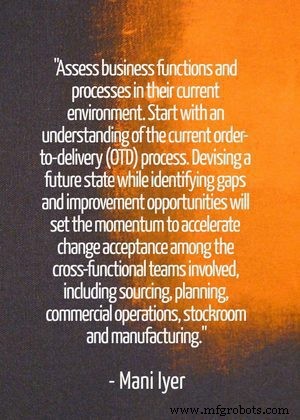
38. Conduct a business assessment. “Assess business functions and processes in their current environment. Start with an understanding of the current order-to-delivery (OTD) process. Devising a future state while identifying gaps and improvement opportunities will set the momentum to accelerate change acceptance among the cross-functional teams involved, including sourcing, planning, commercial operations, stockroom and manufacturing. Key activities in this stage should include:
- Study “As-Is” planning and execution process within the OTD process . Aim to have an unbiased assessment of current processes and practices. Start by interviewing a representative set of stakeholders who perform the same job within each function of the OTD process. Follow up with brainstorming sessions that involve key stakeholders from each function, which will help them understand their upstream and downstream process and address any issues arising out of lack of clarity of roles and responsibilities. These stakeholders should also voice their opinion on the desired “As-Is” state to establish a baseline against which improvements can be measured, and to effectively manage change through shared responsibility among their teams. Organizations should also consider conducting lean workouts among a cross-functional team of subject matter and Six Sigma process experts to understand redundant and non-value-added steps in the process due to multiple hand-offs between various functions within the OTD process.
- Summarize findings and gaps in data, process and practices. One of the ways to effectively capture the gaps in material planning and execution practices is through self-evaluation score sheets. A score sheet typically enlists the various planning and execution categories, and asks the functional owners to score according to the importance and effectiveness of each practice. Typical scoring criteria used is 1 (low), 5 (medium) and 9 (high) to clearly differentiate high impact gaps from lesser ones. For a more robust and objective view, third party service provider can also assist with benchmarking current processes against some of the best run companies in the industry.
- Devise “To-Be” planning and execution OTD process. Resource and system limitations may warrant a “To-Be Intermediate” state before moving to the ideal state. The objective is to outline a streamlined, robust and sustainable process that is aligned to the overall objective of optimizing inventory, customer service levels and variable costs. Organizations then begin to migrate to ideal state once resource and system limitations are addressed.
- Communicate to the whole group the identified improvement opportunities and goals . One of the biggest challenges faced during assessment is change resistance. Data-based inferences and identification of change catalysts is the key to driving fast adoption of more easily implemented improvements. By seeing immediate results, stakeholders will be better engaged to support additional and more sweeping process changes.” – Mani Iyer, Senior Business Manager, Genpact, Inventory Optimization:Five Steps to Improve Process Effectiveness , IndustryWeek; Twitter:@IndustryWeek
39. Understand your sales cycle and customer buying patterns to gain a better understanding of your customers. Effective inventory control is essential for customer service. “Inventory control is a customer service issue. Successful inventory management involves striking that balance between not having enough inventories on hand and having too much. Either you have the cost of excess inventory or the cost of a lost sale. It is painfully obvious which is lesser evil of the two.
“In order to conduct proper inventory control, you must have the ability to look at past sales and predict future demand. When forecasting your demand, you must learn from your past mistakes. Previous marketing promotions must be tracked closely to measure the impact of sales increases. Understanding your sales cycle and customer buying patterns will help you gain a greater understanding of your customers.” – James Ellis of Central Oregon Community College, Inventory Control:An Essential Element of Good Customer Service , Cascade Business News; Twitter:@cascadebusnews
40. Effective inventory control can reduce harmful consequences from mishaps such as the use of outdated or expired materials, such as those used in pharmacy preparations. “Large pharmacies, especially compounding pharmacies, often produce “stores of unwanted chemicals” used in the preparation of prescriptions. These chemicals are known as “bulk compounding chemicals,” and include substances such as tar, phenol and sulfur. Between the chemicals used to prepare prescriptions, pharmacies must also keep track of the compounds and drug products that are ingredients of the final medications. Given the many materials and types of chemicals used and produced, it is especially important for managers to use chemical inventory management systems to organize and keep track of the chemicals that enter and leave a facility.
“As mentioned above, the NECC used expired ingredients in their medications, which likely exposed a number of patients to adverse effects. Additionally, chemicals were not properly labeled. Using a chemical inventory management system prevents such oversight and in all likelihood, NECC lacked such a system. For compounding pharmacies and other such companies which would greatly benefit from tracking chemical supplies, let’s examine three ways a chemical inventory management system can help improve life for both employees and customers:
- Accurate data: The FDA has promised to clamp down on compounding pharmacies as a result of 2012’s incident; however, a random inspection should not be a reason to stress when facilities have a best practices chemical inventory management system in place. Many systems have gone completely digital by using barcode labeling and even providing remote inventory control. In this way, researchers and pharmacists can easily update inventory records, thus providing accurate and real-time data on the chemicals in stock.
- Expiration no more: Expired medications can be dangerous for patients; however, monitoring the expiration dates for both the chemicals used to produce prescription drugs as well as the chemical components of these drugs can be overwhelming. With a chemical inventory management system, managers can easily monitor expiration dates remotely, thus uncovering new opportunities for saving money by ordering less of a minimally used chemical, for example.
- Promote a safety culture: The most damning evidence against the NECC was its inability to create a culture of safety, one in which clear standards and practices are present and individuals are aware of the locations and proper disposal of items. The absence of such a culture perhaps helped contribute to the contamination of medications and it is no wonder that 14 former NECC executives and technicians were indicted on federal charges related to the outbreak. By implementing a chemical management system, leaders help ensure that employees understand the importance of safety and may act accordingly to protect the interests of all.
“What occurred at the NECC proved to be a fatal flaw for the company. Though the presence of a chemical management system may not have prevented the outbreak, if such a system were in place and used in conjunction with a digital notebook capable of recording the results of sterility tests, for example, the likelihood that such a mistake could occur would have been much less.” – Lilian N., Eliminating Harmful Substances Before They Reach Patients with Chemical Inventory Management , Biovia; Twitter:@3dsBIOVIA

41. If your company must maintain inventory for equipment repairs, consider parts that can be used in a number of applications. “If you store clamps and couplings that can be used in a number of applications, you won’t need to keep as many in stock and space is reduced. Full transition couplings that fit pipes of varying types and sizes within your water or wastewater infrastructure save space and help you stay prepared for multiple scenarios. There are also products that have the versatility to either join or repair pipes.” – David Wheat, Simple Steps For Inventory Control , Municipal Sewer &Water; Twitter:@MSWmagazine
Creating Effective Inventory Control Policies
42. Creating clear policies and processes allows your company’s inventory control function to run like a well-oiled machine. “It can be an uphill battle keeping your company’s inventory effectively organized and managed. There are some subtle nuances that are easy to overlook but should ultimately not be ignored. Compass Technologies, which provides retail point-of-sale, wholesale and distribution services to its customers, offers some helpful advice for inventory and organization management.
- Limit access to inventory. Only those who need to have their hands on inventory and inventory data should be allowed access.
- Establish well defined, user-friendly storage and receipt management policies. Check lists and data tables.
- Create an inventory system that utilizes multiple locations to replenish inventory from multiple sites – minimize distribution costs.
- Clearly map and label inventory areas, easy to read and understand with item descriptions.
- Track annual and seasonal regular inventory demand analysis. Use competitive data for start-up companies.
- Track and document inventory processes, including reviews.
- Inventory data base- GP and Add-On solutions.
- Use inventory alerts to make management aware of stock limits.
- Manage paperwork, purchase orders, receipts and inventory counts with GP for reporting.
- Utilize software add-on solutions to further manage the inventory process.” – Hillary Horning, Compass Technologies, 10 Tips for Smooth and Accurate Inventory Organization and Management , ERPSoftware Blog; Twitter:@erpsoftwareblog
43. All items should have an SKU, barcode, and product specifications. “Similar to a driver’s license, every product needs to have a unique ID number known as a SKU (Stock Keeping Unit). A SKU is vital for internal use as there will be instances where a particular product needs to be found quickly and having an SKU will make it easy to find. Additionally, having a SKU is imperative because another company could have a product named “Black Pants” exactly like and resellers are dealing with multiple vendors, thus creating a need to differentiate between similar products.
“Second, when working with other companies such as resellers whether it be an independent e-commerce store, a brick and mortar store or a big-box chain, a universal barcode/UPC number will be expected. A UPC number is another form of a SKU, but instead it comes in the form of a barcode which can be scanned and identified through a live database powered by GS1. Be cautious not to purchase UPC numbers from anywhere but GS1 or a valid reseller. The whole point of a barcode is to be scanned and looked up via a database, so having a barcode that brings up a different product from another company causes a lot of confusion and could potentially lose customers.
“Finally, it is always good to have a system for listing all your products specifications. Those specifications should have at least the following:
- Product Name
- SKU Number
- UPC Number
- Description
- Color
- Size
- Price
- Weight
- Dimensions (depending on product)” – Raad Mobrem, 6 Tips for Inventory Management , Small Biz Resources; Twitter:@SmallBiz_Help

44. Dedicated inventory control managers or other administrators should be tasked with handling the administrative tasks associated with inventory control, and these roles should be separate from accounting or finance departments. “There are many administrative tasks associated with stock control. Depending on the size and complexity of your business, they may be done as part of an administrator’s duties, or by a dedicated stock controller.
“For security reasons, it’s good practice to have different staff responsible for finance and stock.
“Typical paperwork to be processed includes:
- delivery and supplier notes for incoming goods
- purchase orders, receipts and credit notes
- returns notes
- requisitions and issue notes for outgoing goods
“Stock can tie up a large slice of your business capital, so accurate information about stock levels and values is essential for your company’s accounting.
“Figures should be checked systematically, either through a regular audit of stock – stocktaking – or an ongoing program of checking stock – rolling inventory.
“If the figures don’t add up, you need to investigate as there could be stock security problems or a failure in the system.
“Health and safety aspects of stock control are related to the nature of the stock itself. Issues such as where and how items are stored, how they are moved and who moves them might be significant – depending on what they are.
“You might have hazardous materials on your premises, goods that deteriorate with time or items that are very heavy or awkward to move.” – Stock Control and Inventory , Info Entrepreneurs; Twitter:@chambremontreal
45. Make inventory accuracy a higher priority than order fulfillment. “Raising the priority of accurate inventory is perhaps the most important, yet most difficult, step in inventory accuracy. Many inventory problems arise from pushing a transaction through the system with the intent of going back and fixing the numbers later. In the rush of other emergencies, however, we often forget to go back and correct the numbers in the system. This leads to missed production entries, negative lines of inventory, and a whole mess of other problems. Only by putting systems in place that will prevent an employee from moving forward without the necessary system transaction can you effectively keep accurate records of inventory.
“One example of success that my team recently implemented was changing our accounting system so that it will not process any shipment that contains more inventory than we have on hand. For example, if we’re trying to ship 15 of an item, but our system says we only have 5 in stock, then an alert will pop up and force us to fix the problem before moving forward. This helps us address problems before the product goes out the door. By forcing us to address missed production entries before the product leaves, our modified system helped us eliminate most of our major inventory issues.” – Alex Fuller, 10 Tips to Make Physical Inventory Counts Less Painful and More Accurate , Supply Chain Cowboy
46. Inventory management software is a valuable tool and superior to outdated spreadsheet methods. “Using the right tools for the job is a must. Many companies choose spreadsheets for inventory management software because it seems like the familiar and easy thing to do. Unfortunately, spreadsheets come with built-in risks:it’s far too easy to lose changes or accidentally delete a spreadsheet file. It’s also difficult for multiple people to synchronize their spreadsheets, which further increases the risk for error. Find a low-cost but effective software for managing your inventory, such as Peachtree or QuickBooks. Most organizations overlook these options for inventory management because they’re best known for their accounting features. However, they offer invaluable inventory management software features and a central database to streamline inventory operations, increase accuracy, and minimize the possibility of error.” – 5 Supply Chain Management Inventory Tips , Women’s Distributor Services (WDS); Twitter:@WDSJennifer
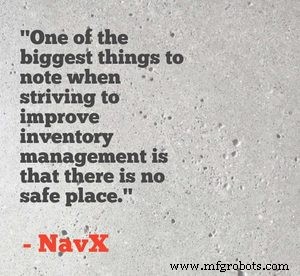
47. Optimizing inventory control requires continuous improvement. “One of the biggest things to note when striving to improve inventory management is that there is no safe place. Maintaining the right balance of inventory levels, properly organizing your warehouse for maximal efficiency, and ensuring that you have complete insight into your processes will go a long way in helping you improve effective inventory management however when you think you’ve succeeded, the worst thing you can do it sit back and relax. Taking a critical approach to operations, including inventory management, is fundamental to maintaining your competitive edge. Be sure to monitor costs as well as performance; if you see that inventory carrying costs are rising, maybe your forecasting isn’t as accurate as it could bet. If customer satisfaction falls, take a look at your order history. If you’re sending out incomplete orders, or items aren’t being sent to customers in a timely manner, dig a little bit deeper. By building the philosophy of continuous improvement into your organization and your inventory management strategy, you will be able to achieve greater efficiency and profitability.” – 3 Tips for Improved Inventory Management , NavX; Twitter:@NAVX_software
48. Cycle counts can be a useful alternative to stock-wide physical inventory counts. “Cycle-counts have become SOP with a growing number of mid-sized firms since more business software packages now provide this functionality. The benefits of employing a cycle-count regimen over periodic stock-wide physical counts are great. Cycle-counts are less disruptive to operations, offer greater specificity in determining what items should be counted and generally force greater discipline into the organization’s inventory management.” – Tips for Improved Inventory Control:Part 5/8 , TBS Automation Systems
49. Take steps to maximize both your profit and resources by involving team members and distributors in key processes. “There are many best practices that any Supply Chain Manager should follow, but a few of the strategies that tend to ensure maximizing not only profits but resources needed include:
- Working with your team and distributor to maximize service and savings; everyone should be clear on the expectations of the strategy you have defined.
- Once strategy is implemented continue consistent monitoring of purchasing behaviors. Many times a focus on efficiencies over time begins to become complacent resulting in overpayment for suppliers and an increase in overall supply chain costs.
- Understand the difference between “cost” and “price.” Many times, the manufacturer costs revealed for the savings analysis do not include the distributor mark-up, holding costs, or the freight costs. Also remember to keep in mind that being able to secure products through a manufacturer directly needs to apply to all of their products in that category, not just one of the more highly utilized items.
- Establish your ability to purchase in the lowest unit of measure. This will ensure that you are not over-ordering on products you may not use frequently or on any consistent basis.
- Be sure of what your GPO compliance requirements are. [This] includes not only volume in units, but may also include dollar-volume commitments. It is important to remember that reducing your pricing on actual supplies may interfere or require an amendment to your GPO agreement in order to maintain compliance. Many times hospitals secure agreements that include commitment to process a set dollar volume through the GPO base agreements that must be fulfilled to maximize the benefits of the entire portfolio.” – Lori Pilla, Vice President, Amerinet Clinical Advantage and Supply Chain Optimization, Amerinet Inc., St. Louis, as quoted in More inventory management best practice tips , HPN Online; Twitter:@HPN_Online, @AmerinetInc
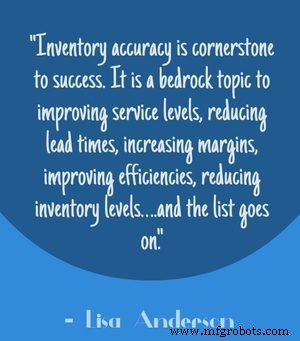
50. Follow best practices for conducting physical inventory counts. “Inventory accuracy is cornerstone to success. It is a bedrock topic to improving service levels, reducing lead times, increasing margins, improving efficiencies, reducing inventory levels….and the list goes on. Although I recommend implementing cycle counting programs as a way to replace physical inventories, there are times when a physical inventory is a must. Thus, it is worth thinking about a few tips to successfully complete a physical inventory.
- Prepare, prepare, and prepare: 80% of your success is in preparation. Organize the warehouse, clearly mark areas, label exceptions, complete and review system transactions, etc.
- Stop/isolate movement: When you begin your physical count, stop all physical and system movements and transactions. This is a critical foundation – similar to building a house, if you start adding windows prior to finishing the walls, the house might begin to fall apart.
- People and communication: Make sure the right people are in the right jobs for their skill sets. And, communicate, communicate, communicate. Make sure everyone has clear instructions, understands how to get questions answered, etc.
- Manage the control desk: This is the term I’ll use for the team organizing and controlling the process – the Grand Central Station hub. Typically, this person/team keeps track of count sheets, makes sure everything “adds up”, answers questions and keeps the process moving.
- Metrics/tracking progress: Putting the key metrics and vehicles in place to track progress is cornerstone to success. By reviewing these metrics, the leader can review progress, make adjustments as required and keep the process on track. Metrics also provide for a way to measure success.” – Lisa Anderson, Tips for Physical Inventory Success , LMA Consulting Group; Twitter:@LisaAndersonLMA
51. Give your employees tools that make them more efficient, which leads to more accurate inventory control. “Other than employees, inventory is a company’s largest asset. Reducing inventory levels and increasing inventory turns can lead to immediate savings on a company’s bottom line. Also, it’s important to consider the “landed cost” of your products. While your supplier may have a book price with bulk discounts, consider how much the product actually will cost you from the time you purchase it to the time it lands at your warehouse dock. Cargo fees, customs, and transportation add up quickly and can shrink profit margins. To navigate these challenges, consider these five tips:
- Reduce compounded safety stock: Most companies keep an extra cushion of inventory to account for unexpected demand. The problem is that when every vendor in a supply chain (raw material supplier, manufacturer, retailer) maintains that extra 5 percent to 10 percent of cushion, it adds up to unnecessary costs for each organization. The key is to communicate closely and often with your suppliers and trading partners to prevent overproduction and increased carrying cost for them. Find ways to collaborate and eliminate excess safety stock.
- Give employees tools to make them more efficient: In tough times, high-quality employees that you strive to retain can get burned out. They likely will absorb the duties of their more expendable colleagues. One way to keep them happier and more productive is to give them the technology tools that will make their jobs easier. Technology that automates tasks or offers predictive models about supply and demand will help reduce the manual aspects of their jobs, so they can focus on driving sales or broader strategies to help grow your business.
- Optimize your inventory: Simply said, you need to get rid of the inventory you don’t sell and get more of the inventory you do. The concept sounds straightforward but many small and midsize businesses have the wrong mix of inventory. While it may be painful to liquidate the inventory you spent precious resources to secure, having it take up warehouse space and require your team to manage it will cost you more in the long run. That space and mindshare could be spent on inventory that is hot and will turn over quicker, and that means more profit in your pocket. Take the short-term hit and implement a system that sheds products that don’t sell and invest in those that do.
- Focus on banner products: Growing up, there were just three kinds of soap at the grocery store:Dove, Dial, and Lava. Now a visit to the soap aisle could add another 15 minutes to a shopping trip because there are just too many choices. By adding variations to your product line versus introducing completely new and different products, you actually cannibalize your own sales and risk confusing customers to the point of apathy. Concentrate on your best products and create customer brand loyalty, which will create “customers for life” versus fickle ones.
- Manage to the future: Understand that in today’s economic climate, cash is king. If you are sitting in a good position, make cutbacks to your spending but invest in tools and people that will help you in the long run to grow your business and drive greater efficiency. With layoffs and companies eager to keep sales high, you can secure some top quality talent and excellent deals on the technology tools you need.
“In times like these, it is key to stay positive but manage realistically, cutting short-term costs that you can afford to cut. The important thing is to understand which assets are mission-critical and which ones need to be shed. Properly managing the No. 1 or No. 2 asset of your company will allow you to cut expenses and increase sales.” – Bill Harrison, Top Five Tips to Rescue Your Business with Inventory Management , AllBusiness; Twitter:@AllBusiness_com
Asset Tracking Solutions from Camcode:
- Controle de estoque
- Inventory Management
- Custom Foil Labels
- Sinais de armazém
- Aisle Signs
- Etiquetas de aço inoxidável
- Etiquetas de piso
- Security Labels
- Magnetic Labels
Tecnologia industrial
- Como as empresas podem aproveitar a IoT para coleta e análise de dados em larga escala
- Transformação digital 101 para OEMs de petróleo e gás - 4 dicas vitais para o sucesso
- Perspectiva futura:IA e análise de dados no controle de guindastes
- 4 tipos de sistemas de controle de estoque:controle de estoque perpétuo versus periódico e os sistemas de gerenciamento de estoque que os suportam
- 3 Dicas para o Gerenciamento de Estoque Hospitalar:Implementando Processos de Rastreamento de Ativos para Agilizar o Gerenciamento de Estoque
- O que é Contabilidade de estoque? Como funciona, tipos de contabilidade de estoque e muito mais
- Códigos de barras versus RFID:qual é a melhor tecnologia de coleta de dados e rastreamento de estoque?
- 27 especialistas em gerenciamento de estoque revelam o método número 1 de controle de estoque para economizar dinheiro em depósitos
- Por que digitalizar formulários e listas de verificação de coleta de dados?
- Parâmetros-chave para a escolha de um método de corte de precisão de 2 eixos



